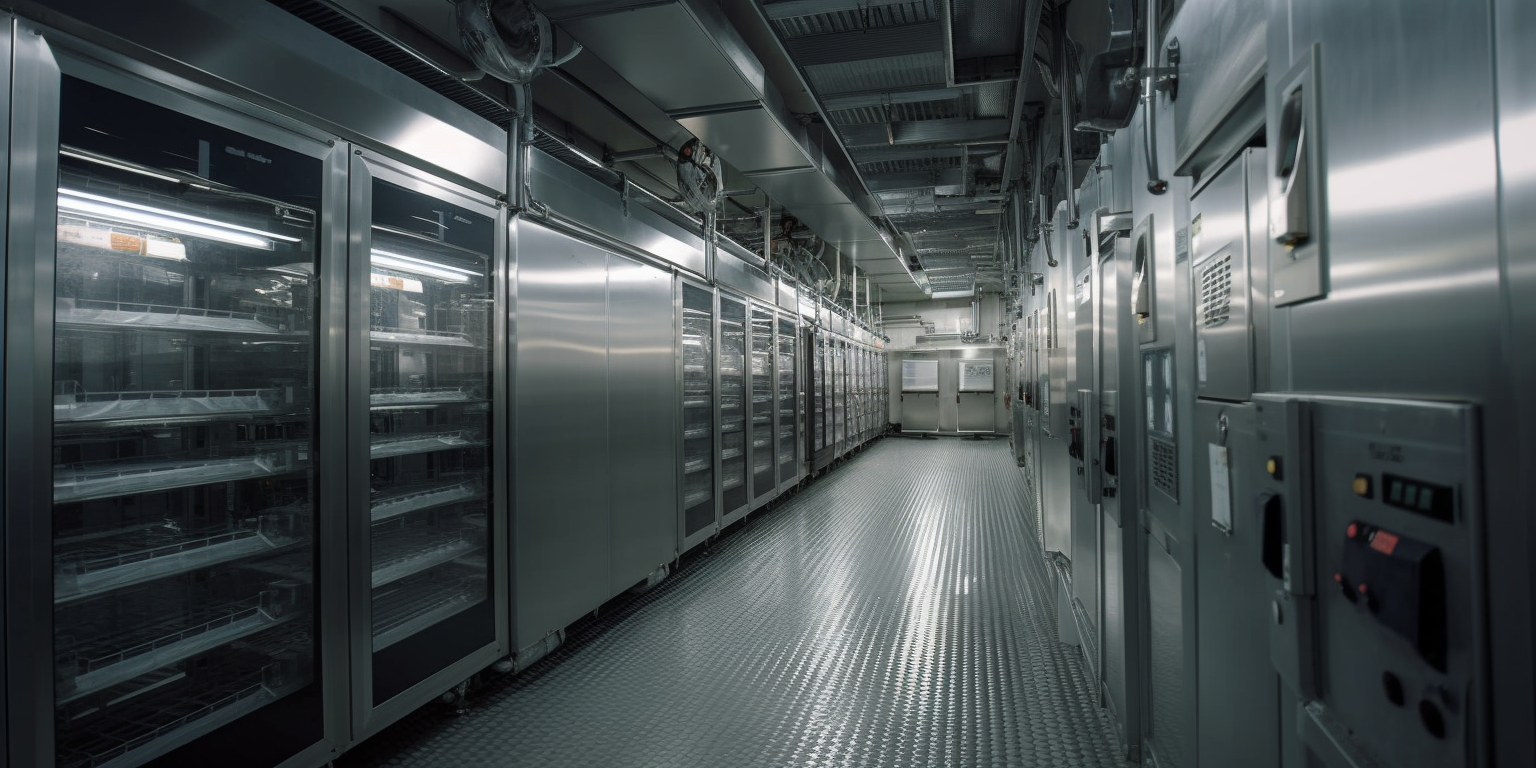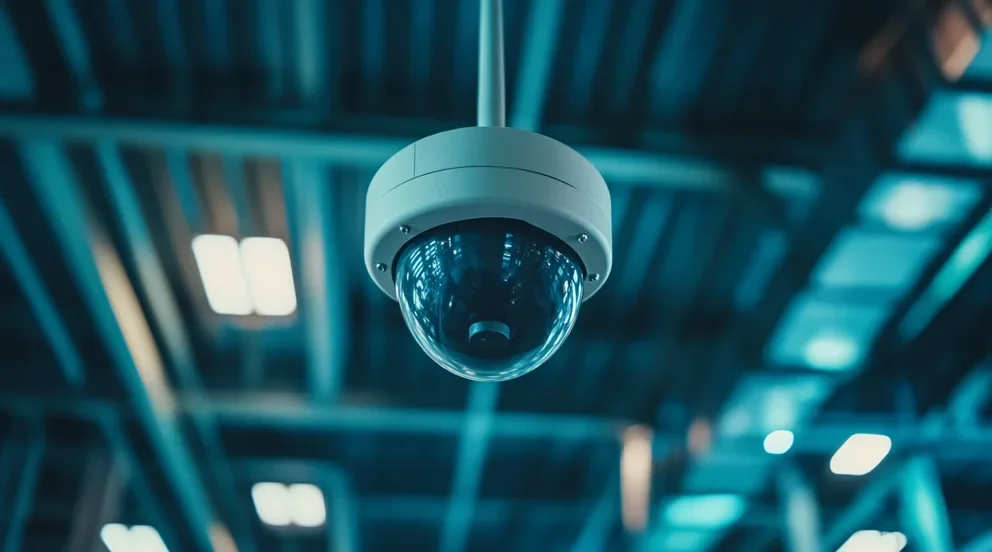Industrial refrigeration, as the term suggests, is a cooling practice used primarily in an industrial setting. It has a broader, more critical role, and is designed to maintain large-scale operations where temperature control is vital, such as in the food processing industry, pharmaceutical production, and chemical plants.
In contrast to residential refrigeration, industrial refrigeration stands out with its complex systems and larger size. These systems encompass vast, interconnected networks of components, all working to control the temperature for a large quantity of products. Tailoring these systems to meet the unique needs of individual industries is also commonly practiced.
Another difference is the refrigerants used. Residential units commonly use hydrofluorocarbons (HFCs), while industrial systems utilize ammonia, a more efficient and environmentally friendly refrigerant, but one that requires more safety measures due to its toxicity.
Finally, the energy consumption and management in industrial refrigeration are significantly different. These systems use a massive amount of energy, so a lot of focus is put on energy efficiency and cost-effectiveness. Regular maintenance and system checks are crucial to ensure smooth operation and to prevent costly downtime.
What are the primary components of an industrial refrigeration system?
Industrial refrigeration systems play a key role in many industries, ensuring optimal storage and manufacturing conditions. These complex systems consist primarily of four main components: the compressor, condenser, expansion device, and evaporator.
The Compressor: Considered the system’s lifeline, the compressor circulates the refrigerant through the setup. It takes in the low-pressure, low-temperature vapor from the evaporator, increasing its pressure and converting it into a high-temperature, high-pressure vapor.
The Condenser: The condenser is where the high-pressure vapor from the compressor gets cooled and converted into a liquid. This conversion process generates heat, which is then dissipated into the surrounding air or water.
The Expansion Device: This unit is responsible for decreasing the pressure of the liquid refrigerant that comes from the condenser. The result is a significant drop in temperature, priming the refrigerant for its entry into the evaporator.
The Evaporator: This is where the actual cooling happens. The low-pressure, low-temperature liquid refrigerant from the expansion device absorbs heat from the surrounding environment, causing it to evaporate and cool the desired area.
In a nutshell, an industrial refrigeration system is a continuous cycle of these four stages, each crucial in maintaining the right temperature for various industrial applications. Understanding the role of each component helps in effective system management, ensuring optimal productivity and efficiency.
How does the choice of refrigerant affect the performance and environmental impact of an industrial refrigeration system?
Choosing the right refrigerant is crucial to the performance and environmental impact of an industrial refrigeration system. Refrigerants are responsible for the system’s ability to cool efficiently. A refrigerant with a high coefficient of performance (COP) facilitates effective heat transfer, leading to optimal system performance. The choice of refrigerant also impacts energy consumption; a more efficient refrigerant can significantly reduce energy usage, lowering operational costs.
However, the environmental implications of refrigerant choice are equally significant. Certain refrigerants, notably those containing chlorofluorocarbons (CFCs) and hydrochlorofluorocarbons (HCFCs), have been found to deplete the ozone layer. Furthermore, many commonly used refrigerants exhibit high global warming potential (GWP). Switching to alternatives with lower GWP can greatly reduce a system’s environmental footprint.
Today, there’s a growing trend towards natural refrigerants like ammonia, carbon dioxide, and hydrocarbons, which boast both high efficiency and low environmental impact. Ammonia, for example, has zero ozone depletion potential (ODP) and negligible GWP, making it a popular choice for environmentally conscious industries.
What are the primary safety concerns associated with industrial refrigeration and how can they be managed?
In the realm of industrial refrigeration, safety is paramount. One primary concern is the potential for refrigerant leaks, which can pose serious health risks to employees and may be harmful to the environment. To manage this, regular inspections and maintenance are crucial. Ensure that refrigeration systems are well-sealed, and invest in leak detection technology for early warning and prompt response.
Another safety concern is the risk of machinery overheating. Overheating can lead to system failure or even fires, posing a significant danger to both personnel and property. Mitigation strategies include regular temperature checks, automated monitoring systems, and proper ventilation for the machinery.
Lastly, there’s the possibility of pressure-related accidents. Industrial refrigeration systems operate under high pressure, and a malfunction could lead to an explosion. To guard against this, ensure pressure relief valves are operational and routinely inspected. Additionally, staff training on correct machinery operation and emergency procedures can also help in managing these risks.
Regular system checks, the application of automated monitoring technology, adherence to maintenance schedules, and comprehensive staff training can effectively manage the safety challenges inherent in industrial refrigeration. Rather than being just a regulatory requirement, safety in industrial refrigeration signifies a continuous dedication to ensuring employee welfare and promoting the efficient operation of the business.
What are the maintenance requirements for an industrial refrigeration system?
Regular maintenance of an industrial refrigeration system is crucial to keep it running efficiently. It starts with a routine inspection that checks all the system components, paying particular attention to the compressors, condensers, and evaporators. Compressors, the heart of the system, require oil checks and changes, along with consistent monitoring for signs of wear.
Condensers need a yearly cleaning to keep them free from dust and debris that might inhibit heat exchange. For evaporators, defrosting is a regular requirement – built-up frost can cause the system to work harder, leading to higher energy costs and potential breakdowns.
Alongside these specific tasks, professionals should monitor the refrigerant levels, ensuring they stay within the manufacturer’s recommended range. Any leaks found must be repaired immediately to prevent loss of refrigerant and potential damage to the environment.
In addition to the hardware, the control systems need regular checks too. Accurate control systems lead to optimized operations, reducing energy consumption and early detection of potential problems.
Finally, keeping thorough records of maintenance activities can provide valuable insights about the system’s overall health and reveal areas that may need attention or upgrades.
What are the regulatory standards and certifications relevant to the industrial refrigeration industry?
Industrial refrigeration, a crucial element in various sectors like food processing, pharmaceuticals, and cold storage, must comply with numerous regulatory standards and certifications. One key standard is the American Society of Heating, Refrigerating, and Air-Conditioning Engineers (ASHRAE) Standard 15, which provides safety protocols for refrigeration systems.
The Process Safety Management (PSM) standard set by the Occupational Safety and Health Administration (OSHA) is major regulation in this arena. The purpose of this rule is to safeguard workers from the potential risks that come with managing refrigerants in an industrial setting.
The Environmental Protection Agency (EPA) also sets regulations, such as the Clean Air Act, mandating the reduction of refrigerant emissions to limit environmental damage.
Moreover, the industry abides by certifications like the International Organization for Standardization (ISO) 22000, which ensures food safety in temperature-controlled environments, and ISO 14001, focusing on environmental management.
Additionally, industry-specific certifications like the Refrigerating Engineers and Technicians Association (RETA) certification, signify the proficiency of professionals working with industrial refrigeration systems.
In summary, staying compliant with these standards and regulations is not only a legal requirement but also a testament to a company’s commitment to safety, environmental sustainability, and high-quality service.
How can energy efficiency be improved in industrial refrigeration systems?
When it comes to improving energy efficiency in industrial refrigeration systems, some simple steps can make a significant impact. First, consider implementing a regular maintenance schedule. Regular check-ups can prevent minor issues from escalating into major problems and can keep your system running at peak efficiency.
Next, look into upgrading your system components. Designers craft modern refrigeration equipment with a focus on energy efficiency. Replacing older components with newer, more efficient ones can lead to substantial energy savings over the life of the system.
Another effective approach is optimizing the refrigeration system’s control strategy. Adjusting the temperature set points and using floating head pressure control can lead to considerable energy savings. Additionally, using energy-efficient practices such as defrosting only when necessary can make a significant difference.
Optimizing insulation can also contribute to energy efficiency. A well-insulated refrigeration system minimizes heat transfer, reducing the amount of work the system has to do to keep cool, thereby saving energy.
Lastly, consider investing in an energy audit. An energy audit can reveal inefficiencies in your system that aren’t easy to spot and provide recommendations on how to further improve the energy efficiency of your industrial refrigeration system.
Remember, increasing energy efficiency in your industrial refrigeration system is not only good for the environment but can also significantly reduce your operational costs, making it a win-win situation.
What are the latest technological advancements in the field of industrial refrigeration?
Industrial refrigeration has seen considerable advancements in the past few years, making strides in efficiency, energy consumption, and sustainability. One of the leading developments is the increasing use of natural refrigerants, like ammonia and carbon dioxide. These substances are not only efficient but also have a significantly lower global warming potential compared to traditional refrigerants.
Another trend is the integration of Internet of Things (IoT) devices in refrigeration systems. Owing to IoT, operators can monitor temperature, pressure, and other vital parameters in real-time, ensuring optimal performance and timely maintenance. It helps in preventing costly breakdowns and reduces energy wastage.
Variable Frequency Drives (VFDs) are another major advancement. They allow the equipment to adjust the compressor’s speed based on the cooling demand, leading to substantial energy savings.
Lastly, the use of predictive analytics is gaining traction in the industrial refrigeration industry. This technology leverages data to anticipate potential system failures and carry out preventive maintenance, ensuring the longevity of the equipment and uninterrupted operations.
In the field of industrial refrigeration, embracing these technological advancements can lead to greater efficiency, lower energy costs, and a reduced environmental impact. These developments are a testament to the industry’s commitment to innovation and sustainability.
Key Takeaways:
The world of industrial refrigeration is ever-evolving, with a robust adherence to regulatory standards and certifications, and a commitment to improving energy efficiency. The industry is embracing cutting-edge technologies, from natural refrigerants to the integration of IoT devices, predictive analytics, and Variable Frequency Drives (VFDs). These advancements not only enhance operational efficiency and reduce energy consumption but also significantly minimize the environmental impact For anyone involved in industrial refrigeration, it’s essential to stay informed and current with these breakthroughs. It ensures the delivery of high-quality service, adherence to safety standards, and a continued commitment to environmental sustainability.



